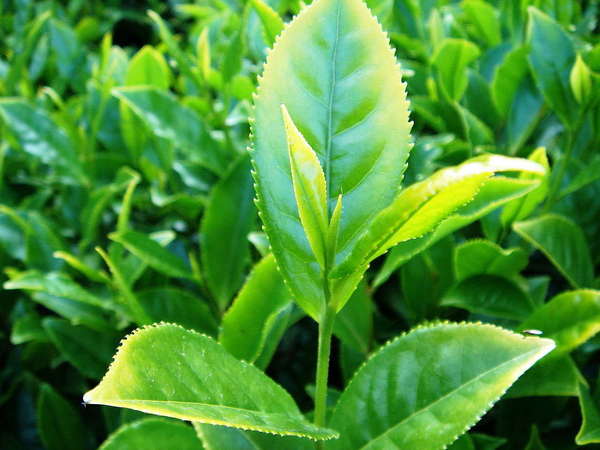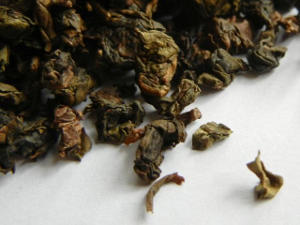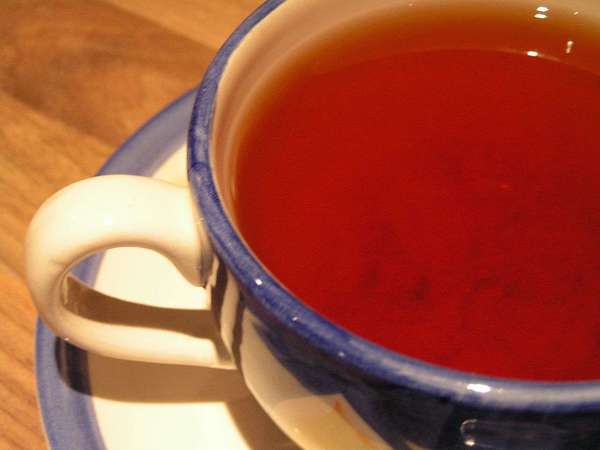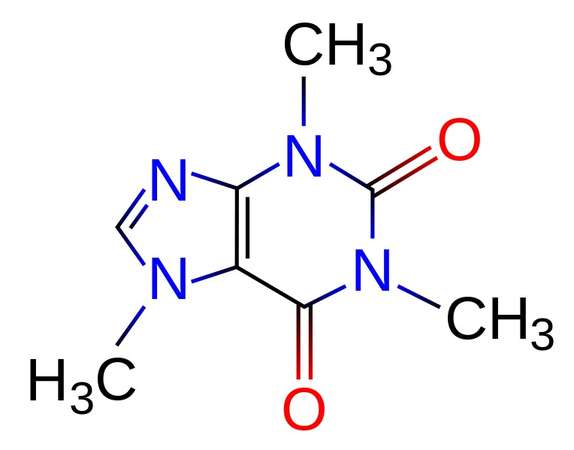Caffeine Content of Tea
Wikipedia: CaffeineLast Updated: Jan. 26, 2018
Quick Summary
- Most tea has 15-70 mg caffeine / cup.
- Coffee tends to have 80-135 mg caffeine / cup.
- It is a myth that green or white teas are always lower in caffeine than black.
- Any color of tea (black, green, white, etc.) can be high or low in caffeine.
About caffeine
Caffeine is a naturally-occurring stimulant, found in several plants. Caffeine is water soluble, and is extracted into the brewed cup when preparing tea, coffee, or other caffeinated beverages.The most well-known plants containing caffeine are tea (Camellia sinensis), coffee, and yerba maté.
Although tea has a number of health benefits, heavy caffeine use has unpleasant effects and negative impacts on health, including anxiety and insomnia, and for this reason many tea drinkers seek to moderate their caffeine intake. The amount of caffeine in tea tends to be low, but is high enough to be a matter of concern for people drinking large quantities of tea, as well as people sensitive to caffeine for medical reasons.
How much caffeine is in tea?
The caffeine content of tea varies widely from one tea to the next, and depends on how the tea is brewed, but tends to be within the range of 15-70mg per 8 ounce cup.Caffeine can also be measured in terms of milligrams of caffeine per grams of dry tea. A teaspoon of dry tea leaves tends to weigh around 2.5 grams, the amount usually used to make a single cup, although this varies by the type of tea. One study of the caffeine content of teas (after steeping) found that the caffeine content of tea varied from about 3 mg/g to 30mg/g, which would result in a cup of tea containing between 7.5 mg and 75 mg of tea.
In most cases, a cup of tea has much less caffeine than coffee; a typical cup of coffee contains 80-135 mg of caffeine. However, it is important to note that these figures are per brewed cup, not per serving, and in the case of large serving sizes, and also with espresso and other heavily-caffeinated drinks, the caffeine per serving can be considerably higher.
In the U.S. the standard "small" serving size is 12 ounces. A recent study of commercial coffee vendors in Australia found that roughly a quarter of espresso samples contained over 120 mg of caffeine per serving, about 1/8th contained 167 mg or more per serving, and the highest contained 214 mg per serving.[1] The authors of this study concluded that the most often-cited figures on caffeine content of coffee tend to underestimate the actual caffeine content.
The caffeine content of tea, by dry weight, is also higher than that of coffee, because a smaller amount of tea is used to brew a single cup, contrasting with an ounce or about 30 grams, used to brew a typical cup of coffee.
How much caffeine is safe to consume?
To place these figures in perspective, the current consensus of the American Congress of Obstetricians and Gynecologists is that it is safe for pregnant women to consume up to 200 mg of caffeine daily.[2] For the general public, the Mayo clinic recommends that 200-300 mg of caffeine daily is safe, but that 500-600 mg daily can cause a number of health problems.[3] People with impaired liver function, and people taking medications that inhibit the CYP1A2 enzyme may have an even lower safe threshold.If drinking a stronger tea containing 60mg caffeine / cup, 8 cups a day would be a safe amount, or 3 for pregnant women. For a weaker tea, with 30mg / cup, twice this amount would still be a safe amount of caffeine. Different people react differently to caffeine, so an amount that is safe or pleasant for one person may not be healthy for everyone.
L-theanine in tea interacts with caffeine
In addition to caffeine, tea also contains L-theanine; theanine can interact with caffeine, allowing a smaller dose of caffeine to have a stronger effect in terms of boosting concentration and alertness. This may explain why tea seems to provide a stronger boost in alertness for some people than one would expect from its caffeine content alone.Do black, green, or white teas contain more or less caffeine?
You cannot generalize about caffeine content by tea type. Many tea companies, and even some reputable entities such as the U.S. Department of Agriculture, have made misleading generalizations about the caffeine content of broad classes of tea. It is a widespread myth that black tea contains more caffeine than green tea, and another myth that white tea contains the least caffeine of all teas.Studies that have actually measured the caffeine content of a large number of different teas have consistently found that caffeine levels vary more among individual teas than across broad categories of tea such as black, white, green, oolong, or pu-erh. A study published in 2005 in the Journal of Food Science listed, among other things, the caffeine content of 77 different teas, and found a broad range of caffeine content among both green and black teas.[4] Surprisingly, the tea in this study that was found to contain the most caffeine was a white tea, solidly dispelling the myth about white tea's caffeine content.
A more recent study in the 2008 Journal of Analytical Toxicology examined the caffeine contents of a number of teas, and found that they ranged from 14 to 61 mg per 6 or 8 oz serving, with "no observable trend in caffeine concentration due to the variety of tea".[5] Few tea companies have examined the caffeine content of a large number of samples of their teas; one that has, Camellia Sinensis Tea House, found similar results, that the caffeine level varies widely from one tea to the next, and does not show clear trends of caffeine levels across different varieties of teas.[6]
One possible exception to this observation is that matcha is known to contain high levels of caffeine, consistently much higher than other teas. This is due in part to higher caffeine levels in the leaf used to produced matcha, but it is also due to the fact that, because matcha is a powdered tea, the entire tea leaf is consumed when brewing, so a cup of prepared matcha contains 100% of the caffeine in the leaf.
What determines the amount of caffeine in a particular tea?
 Caffeine protects the tender young leaf buds of the tea plant from being eaten by insects. Public Domain Photo by Karduelis, Turkish Wikipedia.
Caffeine protects the tender young leaf buds of the tea plant from being eaten by insects. Public Domain Photo by Karduelis, Turkish Wikipedia.Part of the plant used: leaves, stems, or buds/tips
Tea can be made from different parts of the tea plant, and these parts contain different quantities of caffeine. Leaf buds (tips) and younger leaves are higher in caffeine than older, mature leaves.[7] This pattern can be explained by the fact that, for the tea plant, caffeine acts a natural insecticide, serving to protect the plant against being eaten by insects. Since the tips and tender young leaves are most vulnerable to insects, these parts of the plant are highest in caffeine; the older leaves are tougher and thus lower in caffeine. "Tippy" teas such as Yunnan Gold or Silver Needle White Tea (Bai Hao Yinzhen) are thus higher in caffeine than large-leaf teas such as Lapsang Souchong, a black tea (Souchongs are made of mature leaves) or Shou Mei, a white tea.Cultivar or variety of plant grown
The cultivar or specific horticultural variety of tea plant used to produced tea can profoundly affect caffeine levels in tea. Cultivar is independent of type of tea (green, white, black, oolong, etc.), as different types of tea can be produced from the same cultivar. Variation in caffeine content among different cultivars can lead to teas grown under similar conditions, with similar appearance and other qualities, having different caffeine levels. The roasting used to produce oolongs like this Tie Guan Yin removes some of the caffeine. Photo by Alex Zorach.
The roasting used to produce oolongs like this Tie Guan Yin removes some of the caffeine. Photo by Alex Zorach.Processing, especially roasting
Roasting can also reduce the caffeine levels in tea, with greater effect from heavier roasting. In the 2005 study mentioned above, one particular sample of Hojicha, a Japanese roasted green tea, was found to have less caffeine even than some decaffeinated teas.[1]Oolong teas are usually roasted to varying degrees, and can be lower in caffeine, although like all types of tea, oolong teas vary greatly in caffeine content. The roasting processes both for hojicha and oolongs vary greatly, and the caffeine content of most of these teas has not been extensively studied, so it is not safe to conclude that hojicha or roasted oolong is necessarily low in caffeine.
Blending of tea with other ingredients
The blending of tea with caffeine-free ingredients to produce flavored teas can result in a lower total caffeine content so long as less total tea leaf is used in the blend. Scenting tea with flowers or flavoring tea with essential oils of plants does not add as much weight as blending with loose herbs, and thus does not lower the caffeine content (by weight) of the blend as much.How you brew or prepare tea affects caffeine content
The quantity of leaf used and the length of time the leaves are steeped both directly influence the caffeine content of the final cup of tea. Using more leaves and steeping for a longer time both increase the caffeine in the resulting cup. Our page on brewing tea has more discussion of how to brew tea.Can you "decaffeinate" your own tea by steeping it briefly in water?
Short answer: no. A number of sources make the claim that you can "decaffeinate" your own tea by making a brief infusion in hot water, and then discarding this infusion. Unfortunately, this process does not work; if it did, tea companies would not have to resort to expensive and involved decaffeination processes to produce decaf tea. Caffeine tends to diffuse in hot water at the same rate as many of the chemicals responsible for the flavor and aroma of tea, so if the tea still tastes flavorful, it probably still contains caffeine.Most (but not all) herbal teas contain no caffeine
Although caffeine does occur in a number of plants, the overwhelming majority of herbal teas are caffeine free. The most notable exception is yerba mate. Other plants containing caffeine are rare as ingredients in herbal tea; these plants include guayusa, yaupon, and guarana.In addition to exploring other herbal teas, people desiring caffeine-free tea-like drinks might want to try South African rooibos and honeybush, two plants which are often described as being similar to tea in flavor, health benefits, and manner of production.
Labelling of teas on RateTea
On RateTea we label all teas and herbal teas as follows:- Caffeinated - These teas contain caffeine.
- Decaffeinated -
 - Most (not all) of the caffeine has been removed by a decaffeination process.
- Most (not all) of the caffeine has been removed by a decaffeination process. - Caffeine free -
 - These herbal teas do not naturally contain any caffeine. Flavored teas and blends of tea or another caffeinated substance with other, caffeine-free ingredients are labelled as caffeinated.
- These herbal teas do not naturally contain any caffeine. Flavored teas and blends of tea or another caffeinated substance with other, caffeine-free ingredients are labelled as caffeinated.
References
1. Ben Desbrow et. al., An examination of consumer exposure to caffeine from retail coffee outlets, Food and Chemical Toxicology, Vol. 45, No. 9, Sep. 2007, pp. 1588-1592.
2. No Link Between Moderate Caffeine Consumption and Miscarriage, Archive.org, originally published on American Congress of Obstetricians and Gynecologists, Press Release, July 21, 2010.
3. Caffeine: How much is too much?, Mayo Clinic, March 24, 2009.
4. M. Friedman et. al., Distribution of catechins, theaflavins, caffeine, and theobromine in 77 teas consumed in the United States, Journal of Food Science, Vol. 70, No. 9, Nov-Dec. 2005, pp. C550-C559.
5. Jenna M. Chin et. al., Technical Note: Caffeine Content of Brewed Teas, Journal of Analytical Toxicology, Vol. 32, No. 8, Oct. 2008 , pp. 702-704(3).
6. Tea and Health - Analysis of Caffeine, Determination of caffeine by liquid chromatography – UV, in collaboration with College Centre for the Transfer of Technologies TransBIOTech, Retrieved Jul. 16, 2013.
7. Y.S. Lin et. al., Factors affecting the levels of tea polyphenols and caffeine in tea leaves, Journal of Agriculture and Food Chemistry, Vol. 51, No. 7, Mar. 26, 2003 Mar 26, pp. 1864-73.
Further Reading:
Nigel Melican, Caffeine and Tea: Myth and Reality, Cha Dao, Feb. 6, 2008.




